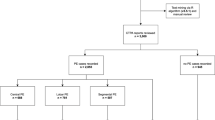Abstract
It remains unexplored if the clinical picture and outcome of subsegmental pulmonary embolism (SSPE) differ between single versus multiple, and incidental versus symptomatic embolism. Consecutive patients anticoagulated for SSPE at the Mayo Thrombophilia Clinic (03/01/2013–12/31/2020) were followed forward to assess venous thromboembolism (VTE) recurrence, mortality, major bleeding, and clinically relevant non-major bleeding (CRNMB); expressed as a rate per 100 person-years. Among 3878 VTE patients, 1541 had pulmonary embolism including 224 (14.6%) with SSPE either single (n = 139) or multiple (n = 85; 46 bilateral and 39 unilateral emboli); 134 had incidental and 90 symptomatic SSPE. Patients with single were less often symptomatic and less often had coexisting DVT than multiple SSPE. Patients with incidental had a two-fold higher frequency of cancer compared to symptomatic SSPE. During the study period, 1 patient with single and 2 with multiple SSPE had VTE recurrence (rate of 1.14 vs 3.63, p = 0.280). Single SSPE patients experienced 2 episodes of major bleeding (rate of 2.36) while the multiple SSPE group had no major bleeding. Seven patients in each group had CRNMB events (rate of 8.20 vs 13.58 for single and multiple SSPE, respectively, p = 0.282). Patients with single SSPE had a higher death rate compared to multiple SSPE (43.07 vs 22.22, p = 0.031) but no difference was noted after adjusting for cancer (p = 0.388). Also, incidental had similar clinical outcomes to symptomatic SSPE.
Interpretation Anticoagulated SSPE patients with single and multiple as well as incidental and symptomatic have a different clinical profile but similar clinical outcomes.
Similar content being viewed by others
Data availability
All stored at designated REDCap.
Code availability
ClinicalTrials.gov: NCT03504007.
References
Beckman MG, Hooper WC, Critchley SE, Ortel TL (2010) Venous thromboembolism: a public health concern. Am J Prev Med 38(4 Suppl):S495-501
Long B, Koyfman A (2017) Best clinical practice: current controversies in pulmonary embolism imaging and treatment of subsegmental thromboembolic disease. J Emerg Med 52(2):184–193
Meaney JFM, Weg JG, Chenevert TL, StaIord-Johnson D, Hamilton BH, Prince MR (1997) Diagnosis of pulmonary embolism with magnetic resonance angiography. N Engl J Med 336(20):1422–1427
Prasad V, Rho J, Cifu A (2012) The diagnosis and treatment of pulmonary embolism. A metaphor for medicine in the evidence-based medicine era. Archives of Int Med 172(12):955–958. https://doi.org/10.1001/archinternmed.2012.195
Kearon C, Akl EA, Ornelas J et al (2016) Antithrombotic therapy for VTE disease CHEST guideline and expert panel report. Chest 149:315–352
American College of Emergency Physicians Clinical Policies Subcommittee (Writing Committee) on Thromboembolic Disease: Wolf SJ, Hahn SA, Nentwich LM, et al. 2018 Clinical policy: critical issues in the evaluation and management of adult patients presenting to the emergency department with suspected acute venous thromboembolic disease. Ann Emerg Med 71: 59‑109
Konstantinides SV, Meyer G, Becattini C et al (2020) 2019 ESC Guidelines for the diagnosis and management of acute pulmonary embolism developed in collaboration with the European Respiratory Society (ERS). Eur Heart J 41:543–603
Bott-Kitslaar DM, McBane RD, Casanegra AI et al (2019) Apixaban and rivaroxaban in patients with acute venous thromboembolism. Mayo Clin Proc 94(7):1242–1252
Wysokinski WE, Houghton DE, Casanegra AI et al (2019) Comparison of apixaban to rivaroxaban and enoxaparin in acute cancer-associated venous thromboembolism. Am J Hematol 94(11):1185–1192
Jimenez D, Aujesky D, Moores L, Gomez V et al (2010) Simplification of the pulmonary embolism severity index for prognostication in patients with acute symptomatic pulmonary embolism. Arch Intern Med 170(15):1383–1389. https://doi.org/10.1001/archinternmed.2010.199
Rosovsky R, Zhao K, Sista A, Rivera-Lebron B, Kabrhel C (2019) Pulmonary embolism response teams: purpose, evidence for efficacy, and future research directions. Res Pract Thromb Haemost 3(3):315–330
Cambron JC, Saba ES, McBane RD, Casanegra AI et al (2020) Adverse events and mortality in anticoagulated patients with different categories of pulmonary embolism. Mayo Clin Proc Innov Qual Outcomes 4(3):249–258
Schulman S, Kearon C, Subcommittee on Control of Anticoagulation of the Scientific and Standardization Committee of the International Society on Thrombosis and Haemostasis. Definition of major bleeding in clinical investigations of antihemostatic medicinal products in non-surgical patients. J Thromb Haemost. 2005;3:692–694
Key NS, Khorana AA, Kuderer NM et al (2020) Venous thromboembolism prophylaxis and treatment in patients with cancer: ASCO clinical practice guideline update. J Clin Oncol 38(5):496–520
den Exter PL, van Es J, Klok FA et al (2013) Risk profile and clinical outcome of symptomatic subsegmental acute pulmonary embolism. Blood 122(7):1144–1149
Bariteau A, Stewart LK, Emmett TW, Kline JA (2018) Systematic review and meta-analysis of outcomes of patients with subsegmental pulmonary embolism with and without anticoagulation treatment. Acad Emerg Med 25(7):828–835
Agnelli G, Buller HR, Cohen A et al (2013) AMPLIFY Investigators Oral apixaban for the treatment of acute venous thromboembolism. N Engl J Med 369(9):799–808. https://doi.org/10.1056/NEJMoa1302507
Prins MH, Lensing AW, Bauersachs R et al (2013) EINSTEIN investigators oral rivaroxaban versus standard therapy for the treatment of symptomatic venous thromboembolism: a pooled analysis of the EINSTEIN-DVT and PE randomized studies. Thromb J 11(1):e21
Stoller N, Limacher A, Mean M et al (2019) Clinical presentation and outcomes in elderly patients with symptomatic isolated subsegmental pulmonary embolism. Thromb Res 184:24–30
Donato AA, Khoche S, Santora J, Wagner B (2010) Clinical outcomes in patients with isolated subsegmental pulmonary emboli diagnosed by multidetector CT pulmonary angiography. Thromb Res 126:e266–e270
Funding
This work was supported by discretionary funds from the Gonda Vascular Center, Mayo Clinic Rochester.
Author information
Authors and Affiliations
Corresponding author
Ethics declarations
Conflict of interest
All authors have declared no conflicts of interest.
Additional information
Publisher's Note
Springer Nature remains neutral with regard to jurisdictional claims in published maps and institutional affiliations.
Supplementary Information
Below is the link to the electronic supplementary material.
Rights and permissions
About this article
Cite this article
Hirao-Try, Y., Vlazny, D.T., Meverden, R. et al. Single versus multiple and incidental versus symptomatic subsegmental pulmonary embolism: clinical characteristics and outcome. J Thromb Thrombolysis 54, 82–90 (2022). https://doi.org/10.1007/s11239-021-02623-z
Accepted:
Published:
Issue Date:
DOI: https://doi.org/10.1007/s11239-021-02623-z




